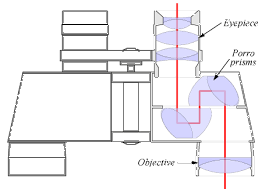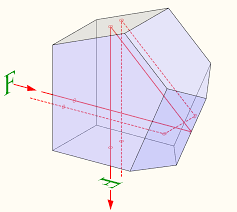
Prisms are used in binoculars. Collect information why prisms are used in binoculars.
Answer
502.2k+ views
Hint: The images formed by the binocular without the prism are inverted. Prisms are used to erect the images formed by binoculars, so that it can be suitable for humans. Also prisms decrease the optical path of light, making the binocular smaller.
Complete Step By Step Solution:
Binoculars are magnifying devices, which make an object appear larger than its actual size. Prism is a transparent, polished optical instrument which refracts light through its surfaces. Prisms are used in binoculars for two primary reasons.
The image formed by the objective lens is laterally inverted and upside down. Prism corrects the orientation of the image and produces an upright image, suitable for viewing by the human eye. Another reason for using prisms in a binocular is reducing the length of the binocular. Prism bends the light rays and reduces the length of the path of light, making the binocular smaller.
Two types of prisms are used in binoculars which are Porro prism and Roof prism. Porro prism consists of four


Note: Roof prism might appear to be simpler than the porro prism, but actually it has a more complex light path. Also the angle between the reflecting surfaces has to be accurate; otherwise the quality of image is degraded. So, roof prisms are required to be made with great precision, which also increases their cost.
Complete Step By Step Solution:
Binoculars are magnifying devices, which make an object appear larger than its actual size. Prism is a transparent, polished optical instrument which refracts light through its surfaces. Prisms are used in binoculars for two primary reasons.
The image formed by the objective lens is laterally inverted and upside down. Prism corrects the orientation of the image and produces an upright image, suitable for viewing by the human eye. Another reason for using prisms in a binocular is reducing the length of the binocular. Prism bends the light rays and reduces the length of the path of light, making the binocular smaller.
Two types of prisms are used in binoculars which are Porro prism and Roof prism. Porro prism consists of four


Note: Roof prism might appear to be simpler than the porro prism, but actually it has a more complex light path. Also the angle between the reflecting surfaces has to be accurate; otherwise the quality of image is degraded. So, roof prisms are required to be made with great precision, which also increases their cost.
Recently Updated Pages
Master Class 12 Business Studies: Engaging Questions & Answers for Success

Master Class 12 English: Engaging Questions & Answers for Success

Master Class 12 Social Science: Engaging Questions & Answers for Success

Master Class 12 Chemistry: Engaging Questions & Answers for Success

Class 12 Question and Answer - Your Ultimate Solutions Guide

Master Class 12 Economics: Engaging Questions & Answers for Success

Trending doubts
Give 10 examples of unisexual and bisexual flowers

Draw a labelled sketch of the human eye class 12 physics CBSE

Differentiate between homogeneous and heterogeneous class 12 chemistry CBSE

Write a short note on Franklands reaction class 12 chemistry CBSE

Differentiate between insitu conservation and exsitu class 12 biology CBSE

What are the major means of transport Explain each class 12 social science CBSE




